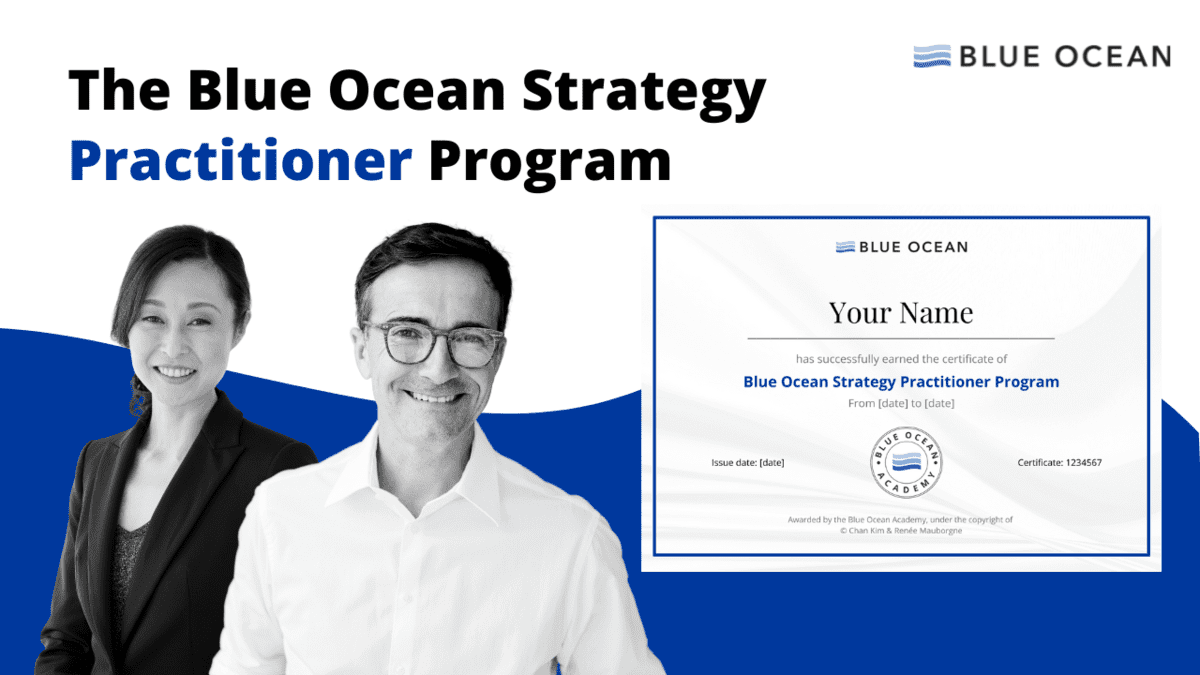-
 Red Ocean vs Blue Ocean Strategy
Red Ocean vs Blue Ocean Strategy
-
 Value Innovation
Value Innovation
-
 Strategy Canvas
Strategy Canvas
-
 Buyer Utility Map
Buyer Utility Map
-
 Three Tiers of Noncustomers
Three Tiers of Noncustomers
-
 Six Paths Framework
Six Paths Framework
-
 Four Actions Framework
Four Actions Framework
-
 ERRC Grid
ERRC Grid
-
 Pioneer Migrator Settler Map
Pioneer Migrator Settler Map
-
 Price Corridor of the Mass
Price Corridor of the Mass
-
 Sequence of Creating a Blue Ocean
Sequence of Creating a Blue Ocean
-
 Five Steps to a Blue Ocean Shift
Five Steps to a Blue Ocean Shift
-
 Three Components of Blue Ocean Shift
Three Components of Blue Ocean Shift
-
 Three Components of Humanness
Three Components of Humanness
-
 Four Hurdles to Strategy Execution
Four Hurdles to Strategy Execution
-
 Fair Process
Fair Process
-
 Tipping Point Leadership
Tipping Point Leadership
-
 Blue Ocean Vs Conventional Leadership
Blue Ocean Vs Conventional Leadership
-
 Leadership Canvas
Leadership Canvas
-
 Blue Ocean Leadership Grid
Blue Ocean Leadership Grid
-
 Four-Step Blue Ocean Leadership Process
Four-Step Blue Ocean Leadership Process
-
 Cost of Disengaged Employees
Cost of Disengaged Employees
TIPPING POINT LEADERSHIP
The conventional theory of organizational change rests on transforming the mass. So change efforts are focused on moving the mass, requiring steep resources and long time frames — luxuries few executives can afford. Tipping point leadership developed by Chan Kim and Renée Mauborgne, by contrast, takes a reverse course. To change the mass it focuses on transforming the extremes: the people, acts, and activities that exercise a disproportionate influence on performance. By transforming the extremes, tipping point leaders are able to change the core fast and at low cost to execute their new strategy.
Conventional Wisdom

Tipping Point Leadership

© Chan Kim & Renée Mauborgne. All rights reserved.
Hence, contrary to conventional wisdom, mounting a massive challenge is not about putting forth an equally massive response where performance gains are achieved by proportional investments in time and resources. Rather, it is about conserving resources and cutting time by focusing on identifying and then leveraging the factors of disproportionate influence in an organization.
By single-mindedly focusing on points of disproportionate influence, tipping point leadership helps managers topple the four hurdles to strategy execution quickly and at a low cost by answering the following questions:
- What factors or acts exercise a disproportionately positive influence on breaking the status quo?
- On getting the maximum bang out of each buck of resources?
- On motivating key players to aggressively move forward with change?
- And on knocking down political roadblocks that often trip up even the best strategies?
-
 Red Ocean vs Blue Ocean Strategy
Red Ocean vs Blue Ocean Strategy
-
 Value Innovation
Value Innovation
-
 Strategy Canvas
Strategy Canvas
-
 Buyer Utility Map
Buyer Utility Map
-
 Three Tiers of Noncustomers
Three Tiers of Noncustomers
-
 Six Paths Framework
Six Paths Framework
-
 Four Actions Framework
Four Actions Framework
-
 ERRC Grid
ERRC Grid
-
 Pioneer Migrator Settle Map
Pioneer Migrator Settle Map
-
 Price Corridor of the Mass
Price Corridor of the Mass
-
 Sequence of Creating a Blue Ocean
Sequence of Creating a Blue Ocean
-
 Five Steps to a Blue Ocean Shift
Five Steps to a Blue Ocean Shift
-
 Three Components of Blue Ocean Shift
Three Components of Blue Ocean Shift
-
 Three Components of Humanness
Three Components of Humanness
-
 Four Hurdles to Strategy Execution
Four Hurdles to Strategy Execution
-
 Fair Process
Fair Process
-
 Tipping Point Leadership
Tipping Point Leadership
-
 Blue Ocean Vs Conventional Leadership
Blue Ocean Vs Conventional Leadership
-
 Leadership Canvas
Leadership Canvas
-
 Blue Ocean Leadership Grid
Blue Ocean Leadership Grid
-
 Four-Step Blue Ocean Leadership Process
Four-Step Blue Ocean Leadership Process
-
 Cost of Disengaged Employees
Cost of Disengaged Employees

BLUE OCEAN SPRINT with AI NAVIGATOR
Kickstart Your Growth, Break Free from Competition, and Redefine Your Market to Seize New Opportunities
Leverage the new AI Navigator, your superpowered Blue Ocean-trained partner in strategy and put it to work for your business.
“LOVED this course. No nonsense, 100% practical tools I can start implementing TODAY in my organisation!” Amalia C., Google
THE BLUE OCEAN STRATEGY PRACTITIONER PROGRAM

Transform your strategic perspective, master blue ocean tools and frameworks, & learn to unlock new growth opportunities
Get started with new market creation with our live, interactive, expert-led program.